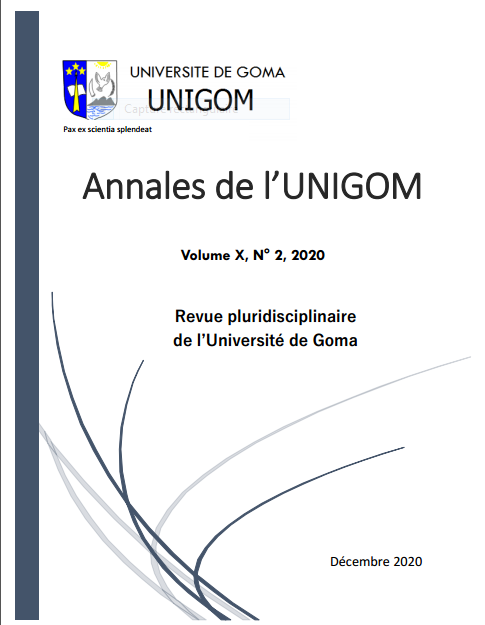Facteurs à la base de l’instabilité externe de la monnaie en République Démocratique du Congo de 2000 à 2018
Contenu principal de l'article
Résumé
Résumé
Moyennant la méthode de moindre carré ordinaire, ce papier avait pour ultime objectif de rechercher les causes de l’instabilité externe de la monnaie dans l’économie congolaise. L’examen des causes probables de taux de change à l’économie congolaise s’effectue au travers une approche hypothético-déductive couplée à une démarche analytique. De manière factuelle, la recherche des résultats nous a conduit à construire une théorie, formuler les hypothèses, à les vérifier, les confirmer ou à infirmer ces hypothèses dans le cadre spécifique de la RD Congo. Pour sa part, la méthode analytique nous a été utile dans l’analyse systématique de toutes les données recueillies de manière à tirer des conclusions qui rendent intelligible notre objet de recherche Cette méthode conclut que la cause de l’instabilité externe de la monnaie est la mauvaise gestion de la monnaie et que cette mauvaise gestion de la monnaie a des répercussions néfastes sur l’économie nationale. Parmi ses effets, nous pouvons citer l’augmentation du niveau général des prix, la dépréciation de la monnaie nationale, la dollarisation, la désintermédiation financière, la fuite des capitaux et in fine la perturbation du fonctionnement de système économique. D’où ces effets se corroborent avec la théorie de Cuthbertson et Brendin (2001) qui stipule que le niveau du PIB, le taux d'inflation et le degré de dollarisation de l'économie ont un impact sur la demande de monnaie et par conséquent cette augmentation de la demande de monnaie pour le motif transactionnel a un impact sur le taux de change.
Abstract
Using the ordinary least square method, this paper had the ultimate objective of examining the causes of the external instability of the currency in the Congolese economy. The investigation of the probable causes of exchange rates in the Congolese economy is carried out through a hypothetico-deductive approach coupled with an analytical approach. In a factual way, the search for results has led us to build up a theory, formulate hypotheses, verify them, confirm them or to invalidate these hypotheses within the specific framework of the DR Congo. The analytical method has been useful to us in the systematic analysis of all the data collected in order to draw conclusions that make our research problem intelligible. This method certifies that the cause of the external instability of the currency is the mismanagement of the currency and that the latter has negative repercussions on the national economy. Among its effects we can cite the increase in the general level of prices in general, the depreciation of the national currency, dollarization, financial disintermediation, capital flight and ultimately the disruption of the functioning of the economic system. Hence its effects are corroborated with the theory of CUTHBERTSON and BRENDIN (2001) which states that the level of GDP, the rate of inflation and the degree of dollarization of the economy have an impact on the demand for money and therefore this increase in demand for currency for the transactional motive has an impact on the exchange rate.
